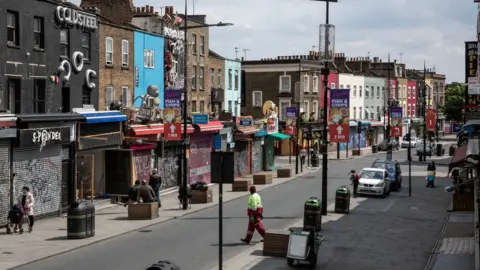Coronavirus: High Streets see 'fastest ever' footfall drop
 Getty Images
Getty ImagesThe number of shoppers visiting UK High Streets, retail parks and shopping centres fell at its fastest rate ever in April as the lockdown forced people to stay indoors, industry figures show.
Footfall fell by more than 80% after all but essential shops closed their doors, according to Springboard.
That was almost double the level of March's downturn when there was a 41.3% drop in visits to shopping locations.
Springboard said the April slump was a "decline of unprecedented magnitude".
Shopping centres were the worst hit by the drop in footfall, as visits fell by 84.8%.
Meanwhile, the number of visits to High Streets around the country fell by 83.3% and footfall at retail parks was 68.1% lower.
The presence of supermarkets and wide-open spaces, which allowed for better social distancing, meant retail parks performed slightly better than other areas, according to the retail analyst company.
Shift in consumer behaviour
"What has become clear, but what is not obvious from the headline rate, is the shift in consumer behaviour away from large towns and cities to smaller more local centres," said Diane Wehrle from Springboard.
At 20 smaller town centres, including Harold Hill, Prescot, Kenilworth and Dudley, footfall decreased by less than 60%.
Meanwhile, major city centres such as Liverpool, Manchester, Nottingham, Bristol and London were among the 20 areas that saw the biggest drops in footfall.
"The overriding focus on safe shopping and the greater emphasis on community that has come to the fore means that trips to larger towns and cities have been curtailed," said Ms Wehrle.
"Indeed, it is the first evidence available that suggests how consumers may respond to easing of restrictions."
She said it was a contrast to "pre-coronavirus days" when small High Streets faced an increasing struggle to attract shoppers.
"The path of recovery for retail may well be led by smaller high streets which can offer both safety and community benefits.
"For larger destinations, the emphasis on safety suggests that those environments that have the capability to control shopper numbers - such as retail parks and shopping centres - will be the next phase of recovery, followed by large towns and cities which inevitably face issues around pedestrian congestion."
